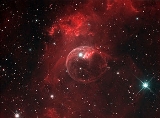
NGC 7635
Encyclopedia
NGC 7635, also called the Bubble Nebula, Sharpless 162, or Caldwell 11, is a H II region
emission nebula in the constellation Cassiopeia
. It lies close to the direction of the open cluster
Messier 52
. The "bubble" is created by the stellar wind
from a massive hot, 8.7 magnitude
young central star
, the 15 ± 5 M☉
SAO 20575 (BD+60 2522). The nebula is near a giant molecular cloud
which contains the expansion of the bubble nebula while itself being excited by the hot central star, causing it to glow. It was discovered in 1787 by Friedrich Wilhelm Herschel. The star SAO 20575 or BD+602522 is thought to have a mass of 10-40 Solar masses.
. Using a 16 to 18 inches (457.2 mm) scope, one can see that the faint nebula is irregular, being elongated in the north south direction.
H II region
An H II region is a large, low-density cloud of partially ionized gas in which star formation has recently taken place. The short-lived, blue stars forged in these regions emit copious amounts of ultraviolet light, ionizing the surrounding gas...
emission nebula in the constellation Cassiopeia
Cassiopeia (constellation)
Cassiopeia is a constellation in the northern sky, named after the vain queen Cassiopeia in Greek mythology, who boasted about her unrivalled beauty. Cassiopea was one of the 48 constellations listed by the 2nd century Greek astronomer Ptolemy, and it remains one of the 88 modern constellations today...
. It lies close to the direction of the open cluster
Open cluster
An open cluster is a group of up to a few thousand stars that were formed from the same giant molecular cloud and have roughly the same age. More than 1,100 open clusters have been discovered within the Milky Way Galaxy, and many more are thought to exist...
Messier 52
Messier 52
Messier 52 is an open cluster in the Cassiopeia constellation. It was discovered by Charles Messier in 1774. M52 can be seen from Earth with binoculars....
. The "bubble" is created by the stellar wind
Stellar wind
A stellar wind is a flow of neutral or charged gas ejected from the upper atmosphere of a star. It is distinguished from the bipolar outflows characteristic of young stars by being less collimated, although stellar winds are not generally spherically symmetric.Different types of stars have...
from a massive hot, 8.7 magnitude
Apparent magnitude
The apparent magnitude of a celestial body is a measure of its brightness as seen by an observer on Earth, adjusted to the value it would have in the absence of the atmosphere...
young central star
Star
A star is a massive, luminous sphere of plasma held together by gravity. At the end of its lifetime, a star can also contain a proportion of degenerate matter. The nearest star to Earth is the Sun, which is the source of most of the energy on Earth...
, the 15 ± 5 M☉
Solar mass
The solar mass , , is a standard unit of mass in astronomy, used to indicate the masses of other stars and galaxies...
SAO 20575 (BD+60 2522). The nebula is near a giant molecular cloud
Molecular cloud
A molecular cloud, sometimes called a stellar nursery if star formation is occurring within, is a type of interstellar cloud whose density and size permits the formation of molecules, most commonly molecular hydrogen ....
which contains the expansion of the bubble nebula while itself being excited by the hot central star, causing it to glow. It was discovered in 1787 by Friedrich Wilhelm Herschel. The star SAO 20575 or BD+602522 is thought to have a mass of 10-40 Solar masses.
Amateur observation
With an 8 or 10 inches (254 mm) telescope, the nebula is visible as an extremely faint and large shell around the star. The nearby 7th magnitude star on the west hinders observation, but one can view the nebula using averted visionAverted vision
Averted vision is a technique for viewing faint objects which uses peripheral vision. It involves not looking directly at the object, but looking a little off to the side, while continuing to concentrate on the object. This subject is discussed in the popular astronomy literature but only a few...
. Using a 16 to 18 inches (457.2 mm) scope, one can see that the faint nebula is irregular, being elongated in the north south direction.

